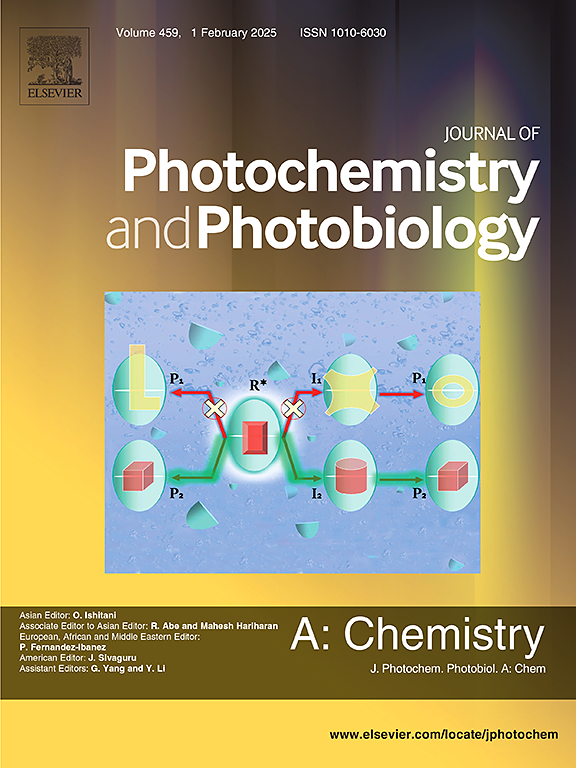Additive-free photocatalytic dehydrogenation of neat formic acid by A COF-Cu heterostructure
IF 4.1
3区 化学
Q2 CHEMISTRY, PHYSICAL
Journal of Photochemistry and Photobiology A-chemistry
Pub Date : 2025-04-03
DOI:10.1016/j.jphotochem.2025.116422
引用次数: 0
Abstract
Selective and efficient dehydrogenation of neat formic acid (FA) under controlled conditions, eg. light, is important yet scarce. Herein, an organic-metal heterostructurre of COF-Cu was constructed by incorporation of Cu2+ with a covalent organic framework AQ-COF. COF-Cu showed a remarkable photocatalytic FA dehydrogenation activity, without any solvent or base additive. The optimal H2 evolution rate reached 190 mmol·g−1·h−1, surpassing most of the state-of-the-art catalyst. The significant performance enhancement of COF-Cu can be attributed to the effective charge transfer process occurring between AQ-COF and Cu2+. This study provides valuable insights for the design of efficient catalysts, crucial for advancing sustainable energy storage technologies.

COF-Cu异质结构无添加剂光催化纯甲酸脱氢
在可控条件下对纯甲酸(FA)进行选择性高效脱氢。光,很重要却又很稀少。本文通过将Cu2+与共价有机骨架AQ-COF结合,构建了COF-Cu的有机-金属异质结构。COF-Cu在不添加任何溶剂或碱的情况下,具有显著的光催化FA脱氢活性。最优的析氢速率为190 mmol·g−1·h−1,超过了目前大多数催化剂。COF-Cu性能的显著提高可归因于AQ-COF与Cu2+之间发生的有效电荷转移过程。这项研究为高效催化剂的设计提供了有价值的见解,这对于推进可持续能源存储技术至关重要。
本文章由计算机程序翻译,如有差异,请以英文原文为准。
求助全文
约1分钟内获得全文
求助全文
来源期刊
CiteScore
7.90
自引率
7.00%
发文量
580
审稿时长
48 days
期刊介绍:
JPPA publishes the results of fundamental studies on all aspects of chemical phenomena induced by interactions between light and molecules/matter of all kinds.
All systems capable of being described at the molecular or integrated multimolecular level are appropriate for the journal. This includes all molecular chemical species as well as biomolecular, supramolecular, polymer and other macromolecular systems, as well as solid state photochemistry. In addition, the journal publishes studies of semiconductor and other photoactive organic and inorganic materials, photocatalysis (organic, inorganic, supramolecular and superconductor).
The scope includes condensed and gas phase photochemistry, as well as synchrotron radiation chemistry. A broad range of processes and techniques in photochemistry are covered such as light induced energy, electron and proton transfer; nonlinear photochemical behavior; mechanistic investigation of photochemical reactions and identification of the products of photochemical reactions; quantum yield determinations and measurements of rate constants for primary and secondary photochemical processes; steady-state and time-resolved emission, ultrafast spectroscopic methods, single molecule spectroscopy, time resolved X-ray diffraction, luminescence microscopy, and scattering spectroscopy applied to photochemistry. Papers in emerging and applied areas such as luminescent sensors, electroluminescence, solar energy conversion, atmospheric photochemistry, environmental remediation, and related photocatalytic chemistry are also welcome.

 求助内容:
求助内容: 应助结果提醒方式:
应助结果提醒方式:


